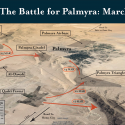 |
 |
Russian-Syrian-Iranian Coalition Seizes ISIS-Held Palmyra

Pro-regime forces seized Palmyra as well as the adjacent Palmyra Airbase in Eastern Homs Province on March 27 after ISIS withdrew from the city, completing an operation that began on March 7 with the aim of recapturing the strategic crossroads. The Syrian Arab Army and its auxiliary National Defense Forces conducted multiple offensives against ISIS in the western countryside of Palmyra in the eight months after its rapid fall to ISIS in May 2015, achieving limited tactical gains at a high cost in manpower and equipment. The latest offensive proceeded as a three-pronged frontal assault similar to previous regime-directed operations against Palmyra, displaying little-to-none of the sophisticated operational design that characterized the recent campaign in Aleppo Province. Instead, the regime relied upon large numbers of reinforcements from Russia, Iran, and other foreign backers as well as a lull in combat generated by a nationwide ‘cessation of hostilities’ that began on February 27 in order to generate sufficient combat power to overwhelm ISIS in Palmyra.
Russia played a major role in enabling the successful seizure of Palmyra following months of indecisive engagements. The Russian Armed Forces shifted the focus of its air campaign against Palmyra and its environs in March 2016 despite a drawdown announced by Russian President Vladimir Putin on March 14. The Russian Ministry of Defense claimed to conduct at least 41 sorties against 146 targets near Palmyra between March 22 and March 24 alone, while local activists reported that the constant aerial bombardment has destroyed up to fifty percent of the city. Russia paired its air campaign with a significant deployment of ground forces. ISIS claimed to kill up to five Russian Spetznaz personnel west of Palmyra on March 18 and posted images appearing to show one of the men standing in front of the symbol of the Russian Main Intelligence Directorate (GRU). Russia later confirmed that at least one special forces officer died near Palmyra while “directing airstrikes onto terrorist targets” near Palmyra. Media reports also revealed the deployment of Russian TOS-1 and BM-30 ‘Smerch’ heavy multiple rocket launcher systems as well as Mi-24 ‘Hind’ helicopter gunships in support of operations to seize Palmyra.
The regime also received significant reinforcements on the ground in Eastern Homs Province in recent weeks, allegedly raising the total number of participants in the operation to over five thousand personnel. Activists noted that the offensive included hundreds of fighters from Lebanese Hezbollah, Iraqi Shi’a Militias, and the Afghan Shi’a Liwa al-Fatimiyoun. The death of a member of the Islamic Revolutionary Guard Corps near Palmyra on March 16 suggests that Iran also deployed its own ground forces in order to oversee its coalition of proxy forces in the operation. Meanwhile, the regime deployed a convoy of up to one thousand Syrian Marines and pro-regime militiamen from the Syrian Coast to Eastern Homs Province on March 18. These redeployments were enabled in part by the ongoing ‘cessation of hostilities’ which allowed the regime and its allies to withdraw troops from its frontlines with opposition groups in Latakia, Aleppo, and Quneitra Provinces without major risk.
The fall of Palmyra represents a major victory on the international stage for both Syrian President Bashar al-Assad and Russian President Vladimir Putin. The new gains allow the Russian-Iranian-Syrian coalition to claim a significant win in the fight against ISIS, bolstering its narrative as the ideal partner in the anti-ISIS campaign. This message may stand to gain additional traction within Europe in the aftermath of a major terrorist attack by ISIS in Brussels, Belgium on March that killed thirty-one civilians and wounded several hundred others. The advance also bolsters the current position of strength held by Syrian President Bashar al-Assad amidst the ongoing Geneva III Talks to end the Syrian Civil War. The seizure of Palmyra curtails the ability of ISIS to project force into Western Syria from its safe haven along the Euphrates River Valley and provides a much-needed buffer for several critical regime-held oil and natural gas fields that provide electricity to Western Syria. The regime and its allies will likely leverage Palmyra and its military facilities as an optimal forward position for follow-on operations against ISIS in Ar-Raqqa and Deir ez-Zour Cities, complicating the position of the U.S.-led coalition in the region.